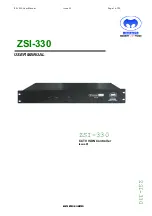
6
ATtiny26(L)
1477G–AVR–03/05
AVR CPU Core
Architectural Overview
The fast-access Register File concept contains 32 x 8-bit general purpose working reg-
isters with a single clock cycle access time. This means that during one single clock
cycle, one ALU (Arithmetic Logic Unit) operation is executed. Two operands are output
from the Register File, the operation is executed, and the result is stored back in the
Register File – in one clock cycle.
Six of the 32 registers can be used as 16-bit pointers for indirect memory access. These
pointers are called the X-, Y-, and Z-pointers, and they can address the Register File
and the Flash program memory.
Figure 2. The ATtiny26(L) AVR Enhanced RISC Architecture
The ALU supports arithmetic and logic functions between registers or between a con-
stant and a register. Single register operations are also executed in the ALU. Figure 2
shows the ATtiny26(L) AVR Enhanced RISC microcontroller architecture. In addition to
the register operation, the conventional memory addressing modes can be used on the
Register File as well. This is enabled by the fact that the Register File is assigned the 32
lowermost Data Space addresses ($00 - $1F), allowing them to be accessed as though
they were ordinary memory locations.
The I/O memory space contains 64 addresses for CPU peripheral functions as Control
Registers, Timer/Counters, A/D Converters, and other I/O functions. The I/O Memory
can be accessed directly, or as the Data Space locations following those of the Register
File, $20 - $5F.
1024 x 16
Program
FLASH
Instruction
Register
Instruction
Decoder
Program
Counter
Control Lines
32 x 8
General
Purpose
Registers
ALU
Direct Addressing
Indirect Addressing
Status
and Test
Control
Registers
Interrupt
Unit
2 x 8-bit
Timer/Counter
Universal
Serial Interface
Watchdog
Timer
Analog
Comparator
I/O Lines
8-bit Data Bus
ISP Unit
ADC
128 x 8
SRAM
128 byte
EEPROM







































